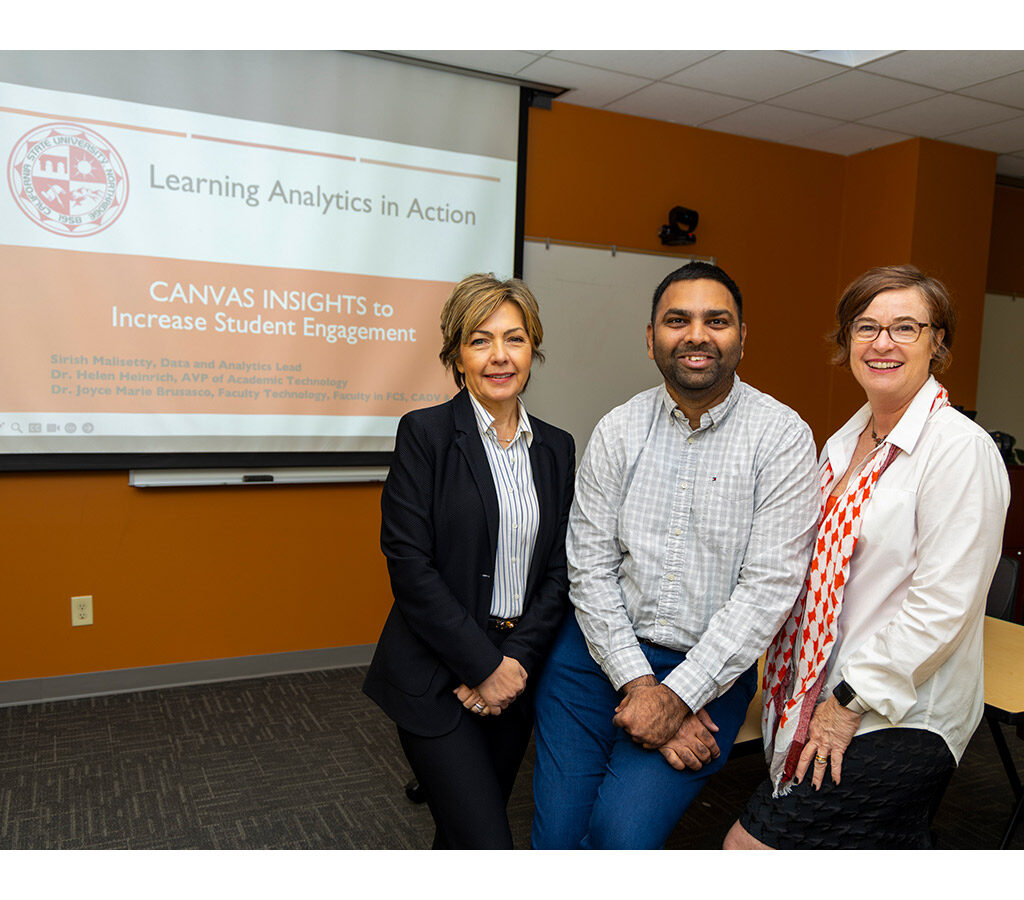
For Joyce Marie Brusasco, a lecturer in in family and consumer sciences, child and adolescent development, and academic first year experience courses, communicating with her students is a priority — whether it’s complimenting someone on acing a test, or encouraging another to seek help during office hours. But with anywhere from 150-200 students a semester, keeping up can be daunting— even in the era of online learning management systems, like Canvas.
What’s helped her is Canvas Insights. It’s an online tool that was developed within CSUN’s IT Department— designed to spark discussions, boost participation, and bring students out of their shells. The platform is changing how CSUN faculty interact with their students to help facilitate their success— and it has been shared across the CSU, at technology conferences and with other universities.
What is Canvas Insights?
Canvas Insights allows professors to apply multiple filters and create personalized, current views of students’ work and engagement within Canvas throughout the semester. Faculty can then email those students right from the same platform. Faculty members who use the tool said it has saved them hours of work— and has eliminated the need for a cumbersome work-around that involved setting up and constantly updating spreadsheets.
“It’s about timely intervention and personalizing support for students when they need it most,” said Sirish Malisetty, the data and analytics development lead who spearheaded the project. “One of the biggest barriers to student success isn’t lack of ability. It’s a lack of connection or timely feedback. That’s where this tool makes a meaningful difference,” he said.
Since Canvas Insights’ introduction in 2019, Malisetty notes that more than 21,000 personalized emails have been sent.
How Did Canvas Insights Come About?
Canvas became the learning management system at CSUN in 2017, and as faculty members began using it, Malisetty was directed to do a deep dive into its extensive data collection, which includes grades, students’ logins, and assignment submissions. Helen Heinrich, the associate vice president for Academic Technology, was the director of data and analytics for Information Technology at that time
“Sirish developed the capacity to pull and visualize Canvas data, and when we first saw what was possible, we were in awe,” she said. “Our immediate thought was, how can faculty leverage their own data? We wanted to find a way to turn that data back to instructors so they could use it to help their students succeed,” she noted.
Malisetty said the newly discovered data revealed information about student engagement, performance and behavior — which could be used to help students immediately, during the semester — not just after the fact.
“Most of the reporting [previously] available to faculty, advisors and administrators was focused on semester-end metrics like GPA or enrollment trends,” he explained. “But by the time those numbers became available, it was already too late — students had already failed, disengaged or dropped out,” he said.
Malisetty said what makes the new tool a real powerhouse for professors is the ability to apply multiple filters simultaneously, which isn’t possible in typical Canvas views. For example, he notes, a professor can quickly pull up a list of students who have a low total grade; or those who haven’t accessed the syllabus or grade book pages; or others who have missed a specific assignment. They can then send a personalized message to those groups of students.
“Before tools like Canvas Insights, faculty would reach out to students using general Canvas messages or announcements, which often went unnoticed or lacked personal relevance,” he explained. “Now, faculty can send targeted, one-on-one messages based on real engagement patterns.”
Developing and Implementing Canvas Insights
Heinrich said over time, multiple colleagues took part in the project, contributing to its technical development— then faculty members, including Brusasco, tested the tool and provided feedback and suggestions.
“We always tell faculty that Canvas Insights is our co-creation, and we will keep enriching it based on their ideas. That’s the beauty of building tools in-house: we can update them as needs arise,” Heinrich said.
For Malisetty, creating the new tool meant developing new skills: He learned the Python computer programming language in depth. He also worked with staff at Canvas to learn more about the application programming interface (API) — a set of protocols that allows different software applications to communicate and share data.
Workshops and clinics to teach faculty how to use Canvas Insights are still held regularly. Hands-on trainings were held at the end of August and early September in partnership with the Office of Student Success. There are also instructional videos on YouTube and on the Canvas Insights webpage.
CSUN and Beyond
Since Canvas Insights’ creation, its developers have presented it at conferences, including the CSU Tech Conference , the Higher Education Data Warehouse conference , and at CSU Academic Technology meetings.
Malisetty’s work was recognized with the 2025 President’s Award at the annual Staff Service and Recognition of Excellence Awards on campus last June — and other schools across the country have been in touch, asking what it took to develop the tool. Heinrich has called the years-long effort a “labor of love.”
“We feel fortunate at CSUN to have the people we do, because this combination of innovative minds, technical expertise, and genuine care for students is truly unique,” she said.


